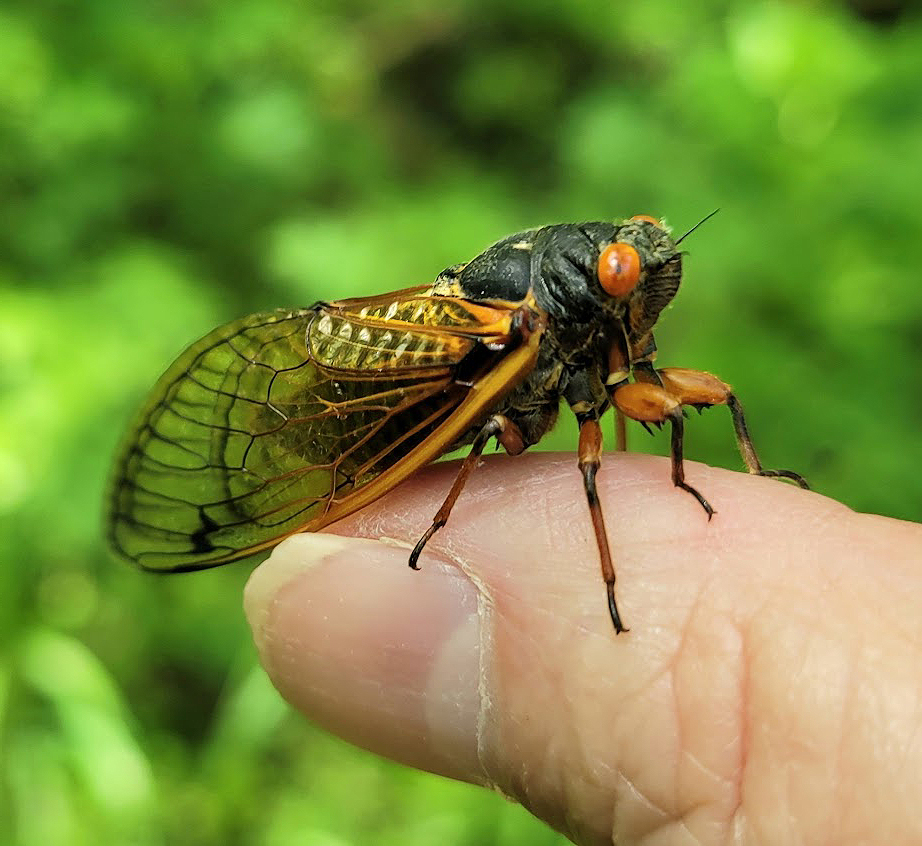Even our learned third president, Thomas Jefferson, who was very well educated, called them locusts in the garden journal he kept at Monticello.
“Dr. Walker says he remembers that the years 1724 & 1741 were great locust years, we all remember that 1758 was and now they are come again this year 1775. It appears then that they come periodically once in 17 years, they come out of the ground from a prodigious depth, it is thought that they eat nothing while in this state, laying their eggs in the small twigs of trees seems to be their only business. The females make a noise well known. The males are silent.”
Mr. Jefferson’s account was accurate except it’s the males that create the noisy raucous and they are simply not locust.
Locusts are related to grasshoppers and are in the insect order Orthoptera. They do have mouthparts and in mass would eat an enormous amount of plant material. Cicadas, in the order Hemiptera, cause our curious odd year chaos. The above ground adults do not have mouths. Their sole purpose at life’s end is to reproduce by the millions.
Adult cicadas do not eat, but they are highly edible. In many parts of the world cicadas are eaten by humans and when a brood of periodical cicadas boils out of the ground birds and other wildlife feast on them.
It is believed that our periodical cicadas have evolved into their unique 13- or 17-year lifecycles to confuse the predators that might attempt to synchronize their own 2- or 3-year lifecycles to take advantage of the abundance of edibles ever so often, but no other species has been able to do that.
It is also believed that the sheer number of a million per acre overwhelms predators as well. The earliest cicadas to climb from the ground and molt get eaten readily but after a few days predators’ appetites for cicadas is sated. Days later the emerging cicadas are ignored and are able to reproduce. In this case, being late is rewarded.
Why is 2024 special?
Nature is orderly. Yet, sometimes things happen for unfathomable reasons.
“Whatever the circumstances are that lead to the evolution of this life-history pattern, they are rare, and the rare things are always the hardest things to study,” said University of Connecticut biologist John Cooley in Scientific American.
The 15 broods of periodical cicadas emerge in a precise fashion, roughly one a year somewhere in the east. But because 12 populations are on a 17-year cycle while three are 13-year cycles, every 221 years two emergences fall in the same year. In 2024, we’ll see the most northerly 17-year Brood XIII and the Great Southern 13-year Brood XIX line up. From south Alabama to south Wisconsin there will be millions of cicadas creating a racket across 16 and perhaps 17 states. But only in eastern Iowa and northern Illinois will the two separate broods overlap with a net yield of billions.
So when does the pandemonium begin?
When ground temperatures reach 64 degrees roughly 8 inches below the surface, periodical cicadas begin to dig their way out. It’s time to mature.
But don’t be afraid you’ll miss it. Starting in May, it’ll probably last six weeks or more at any given location as it works its way north. Brood XIX alone will be scattershot across 13 states. There’s another odd number.
While having such an enigmatic, convoluted social structure, their basic life cycle is straightforward. Although the adults do not have mouthparts, their nymphs do. It’s these young ones that spend their entire lives underground sipping carbohydrates from roots and slowly growing until time to tunnel out, molt into adults and find partners. Once mated, a female can lay up to 400 eggs in slight slits she cuts in tender twigs of trees and shrubs. After 6 to 10 weeks, tiny cicada nymphs hatch from the eggs and immediately fall back to terra firma to start the whole thing over. Yet, Brood XIX and XIII will not emerge together again until the year 2245.
